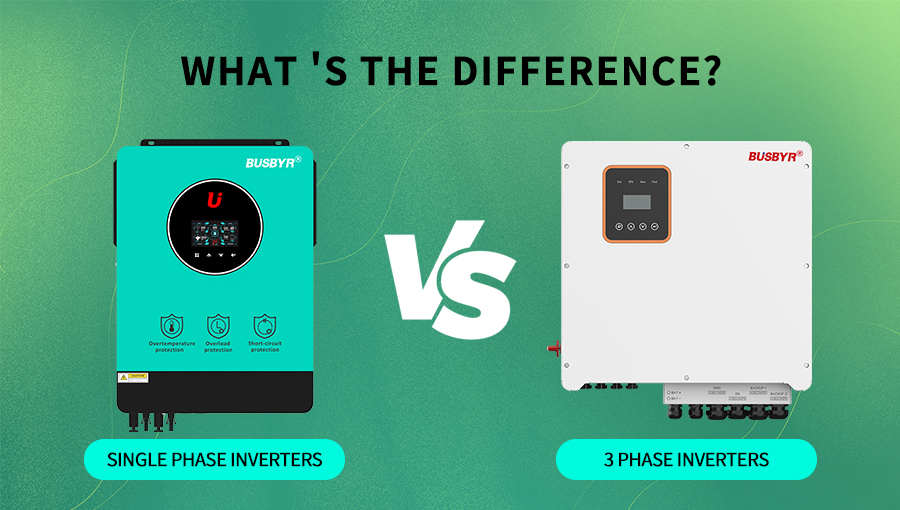News
Inverters are crucial components in many electrical systems, transforming DC power into AC power for a myriad of applications. Among these, single-phase and three-phase inverters are commonly utilized, each serving similar purposes but with distinct differences that render them more suited to specific applications. This article delves into these differences, including their advantages, disadvantages, and typical uses.
Single Phase Inverters
Predominantly found in residential and small commercial settings, single-phase inverters convert DC to AC power using a single sine wave, causing the voltage to oscillate positively and negatively 120 or 240 times per second, respectively. This sine wave's positive and negative alternations produce a waveform resembling a sine curve.
The main advantage of single-phase inverters lies in their simplicity and cost-effectiveness. Their reliance on a single sine wave simplifies their electronic requirements, making them cheaper to produce. However, this simplicity comes with downsides. Single-phase inverters offer lower power output and less stable voltage regulation compared to their three-phase counterparts, making them less ideal for high-power or large-scale applications.
Typically, single-phase inverters are utilized in residential solar power systems, small appliances, and other low-power needs. They are particularly useful in regions with unstable or unreliable power grids, as they can easily integrate with battery backup systems.Click to View busbyr Single Phase Inverter.
Three Phase Inverters
Three-phase inverters generate AC power using three sine waves, each phase shifted by 120 degrees. This configuration allows for oscillations between positive and negative 208, 240, or 480 times per second, enabling higher power output, more stable voltage regulation, and increased efficiency over single-phase inverters. However, this also means they are more complex and costly to produce.
A significant advantage of three-phase inverters is their capacity for high power output, making them ideal for large-scale commercial, industrial power systems, electric vehicles, and other high-power demands. Their efficiency and stable voltage regulation also make them suitable for critical power applications.
Nonetheless, three-phase inverters are generally more expensive than single-phase alternatives and come with more complicated electronics. This complexity can complicate installation and maintenance.Click to View busbyr 3 Phase Inverter.
Comparison of Single Phase and Three Phase Inverters
When deciding between single-phase and three-phase inverters, various factors must be weighed. The voltage and current output differ, with single-phase inverters offering 120 or 240 volts AC, and three-phase inverters offering 208, 240, or 480 volts AC. Additionally, three-phase inverters typically deliver higher power output and efficiency, thanks to their tri-sine wave operation.
Other considerations include the application's size and complexity, the necessity for voltage regulation, and the inverter's cost and efficiency. For smaller applications, like residential solar power systems and small appliances, the simplicity and lower cost of single-phase inverters might be more appealing. Conversely, for larger-scale needs, such as commercial and industrial power systems, the superior power output and efficiency of three-phase inverters often make them the preferred choice.
Three-Phase Inverter | Single-Phase Inverter | |
Definition | Generates AC power using three sine waves that are 120 degrees out of phase with each other | Generates AC power using a single sine wave |
Power Output |
| Lower power output |
Voltage Regulation | More stable voltage regulation | Less stable voltage regulation |
Design Complexity | More complex design | Simpler design |
Cost | More expensive | Less expensive |
Advantages | Suitable for large-scale commercial and industrial power systems and electric vehicles; More stable voltage regulation; Higher power output | Less expensive; Simpler in design |
Single Phase to Three Phase Inverter
There are instances where single-phase power is available, but a three-phase inverter is required. In such cases, a phase converter can be used to transform single-phase power into three-phase power. This device takes the single-phase input and generates two additional power phases, which, when combined with the original phase, produce a three-phase output. Various phase converters, including static, rotary, and digital types, can achieve this conversion.
Conclusion
The decision between single-phase and three-phase inverters hinges on the specific needs of the application. Single-phase inverters are simpler and more affordable but offer lower power output and less stable voltage regulation. In contrast, three-phase inverters, though more complex and costly, provide higher power output, efficiency, and stability. By considering the discussed factors, the appropriate inverter type for any given requirement can be selected. If unsure about choosing the right hybrid solar inverter, consulting with our product manager for a cost-effective inverter quote is advisable.



